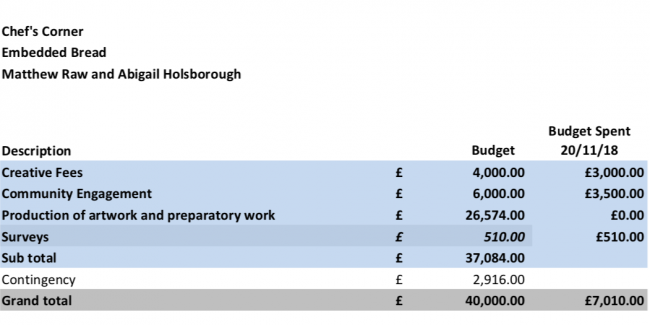LBWF’s Making Places programme and the Cann Hall side-wall fiasco: good news and bad
As a previous post has described in detail, LBWF currently plans to spend a dizzying £40,000 on tiling the large side-wall of a private commercial property in Cann Hall ward, all in the name of producing a ‘joyous’ and ‘popular’ piece of public art, Matthew Raw and Abigail Holsborough’s Embedded Bread.
The good news is that because of widespread local disquiet (and in particular a petition with well over 450 signatories) LBWF has just put the project ‘on hold’ (even if, to residents’ amusement, it is apparently incapable of explaining exactly what this means).
However, there is plenty of bad news too.
First, a new Freedom of Information Act deposition reveals that, though the tiling itself is yet to begin, getting on for a quarter of the planned budget already has been spent:
Some of the detail here also causes concern. Raw and Holsborough have promised to run ten ‘community engagement workshops’, where a ‘range of local groups and individuals’ will hand-craft a small number of the tiles to be used, and in the last couple of weeks some of these workshops have taken place, with the ward councillor responsible for overseeing the project, Sally Littlejohn, shepherding in the participants.
However, these arrangements are rather more controversial than they at first sight appear. Publicity for the workshops has been disseminated at the last minute, and largely on specialist social media, an unusual way of generating popular engagement – always assuming this was the real purpose. Moreover, the fact that each of the events is costing £600 will strike many as excessive, not least because venues in the area can be hired at a modest fraction of that sum.
So much for the budget, but there is growing unease, too, about how the project is being managed. One expert contractor who LBWF approached to carry out the exacting work of hanging Raw and Holsborough’s tiling has commented as follows:
‘The wall isn’t in bad condition really for an end of terrace…The cladding won’t directly damage it, but certainly won’t do it any good. Actually…I remember the lady from the council saying they were just going to adhesive the tiles in, and when I stated that they would need to be dowelled in for safety, she kind of shrugged and changed topic. They don’t care about things being done properly, all they care about is saving money, haggling for cheap, despite it meaning the job may not be safe or proper…To completely restore [the wall]…back to exposed brickwork, and repoint it would be in the region of £18-20,000. To make repairs and stabilise the base coat [to prepare for the tiles] would probably be around £10,000. It was a sketchy arrangement, [and]…I wasn’t really into subcontracting for the council as you wait months and months for payment’.
Given that the integrity of the side-wall bears so heavily on the success of the final outcome, such evidence is especially damning.
Third, and probably most alarming of all, is the fact that no one in authority appears willing to take any responsibility for what’s occurred, and some are even resistant to the idea that anything untoward has happened at all. Addressing a recent public meeting, for example, LBWF Head of Culture and Heritage Services, Lorna Lee, repeatedly insisted that the consultation to decide where precisely the artwork in Cann Hall should be sited was ‘very successful’ – somewhat surprising, to say the least, given that the exercise she was referring to had elicited a mere 22 responses from a local population exceeding 15,000.
In summary, no one associated with the history of Embedded Bread emerges with much credit. Cllr. Littlejohn appears to have been misled by hubris into believing that she has the public ear. Raw and Holsborough may be well regarded in the world of publicly funded art, as they are quick to claim. But in this case they have started from stale and patronising clichés, and, as several local wags have observed, then fashioned an end product which would not look out of place in a public urinal – a happy irony, because during the bacchanalia of Friday and Saturday nights, that is exactly what the side-wall site often becomes. And as for LBWF, in true style it has simply plunged on regardless, apparently intent on doing something – anything – rather than admit its mistakes.
Returning to the good news, however, what’s heartening is that, in Cann Hall right now, large numbers of people have said ‘enough!’, and it is they who currently hold the field.

